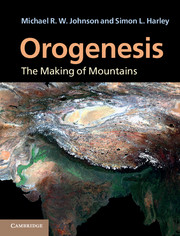Book contents
- Frontmatter
- Contents
- Preface
- Acknowledgments
- Geological timescale
- 1 Major features of the Earth and plate tectonics
- 2 Driving mechanisms for plates, slab retreat and advance, and a cause of orogenesis
- 3 Physical and chemical principles: rock deformation, isostasy, geochronology and heat production in the lithosphere
- 4 Large-scale features of orogens: thrusts and folds
- 5 Evolution of orogens
- 6 Lateral spreading of orogens: foreland propagation, channel flow and weak zones in the crust
- 7 Metamorphism in orogeny
- 8 The erosion and exhumation of mountains
- 9 Sedimentary history of the foredeep basins
- 10 Deep structure, mountain support and phase changes
- 11 Mountains and climate
- 12 Secular change in orogeny
- References
- Index
- Plate section
- References
5 - Evolution of orogens
Published online by Cambridge University Press: 05 June 2012
- Frontmatter
- Contents
- Preface
- Acknowledgments
- Geological timescale
- 1 Major features of the Earth and plate tectonics
- 2 Driving mechanisms for plates, slab retreat and advance, and a cause of orogenesis
- 3 Physical and chemical principles: rock deformation, isostasy, geochronology and heat production in the lithosphere
- 4 Large-scale features of orogens: thrusts and folds
- 5 Evolution of orogens
- 6 Lateral spreading of orogens: foreland propagation, channel flow and weak zones in the crust
- 7 Metamorphism in orogeny
- 8 The erosion and exhumation of mountains
- 9 Sedimentary history of the foredeep basins
- 10 Deep structure, mountain support and phase changes
- 11 Mountains and climate
- 12 Secular change in orogeny
- References
- Index
- Plate section
- References
Summary
In this chapter we will be looking at the evolution of several types of Phanerozoic orogenic belts. Precambrian orogenesis will be dealt with in Chapter 12. The Himalaya and the Alps are part of a huge belt of Cenozoic age which runs from the Pyrenees through the Balkans into Turkey and on to the Middle East, Pakistan and India into Burma. There is also a leg from the Betic Cordillera to the Rif in North Africa and via Corsica to the Ligurian and Internal Western Alps. These parts were the result of the collision of Gondwanaland (the Late Palaeozoic assemblage of South America, Africa, India and Antarctic) and Eurasia (Europe and Asia). We also consider the Andes and the Caledonides in order to illustrate different types of orogens. For the present, examples are confined to the Cenozoic orogens because, as mentioned above, the younger mountain belts offer a better chance of understanding evolutionary processes in orogenesis than the older deeply eroded belts in which much of the evidence is missing (see Chapter 12).
In the now discarded geosynclinal theory of orogenesis as set out for example in Holmes's Principles of Physical Geology (Holmes, 1944), the pre-orogenic phase was a precursor of the orogenesis because the sedimentary and igneous rocks deposited in the geosyncline were already undergoing compression and so were predestined to become involved in orogeny, the point being reinforced by the postulated downward flow of mantle convection cells which led the whole process. Plate tectonics introduced a paradigm shift which included a denial of any link between the events occurring before orogenesis and the orogeny itself; this is well demonstrated by the Swiss Alps which were undergoing extension not compression before orogeny. The attempt to separate temporally extensional and compressional strain events is much too simple. For example, compressional strain in forearc wedges may be synchronous with extensional strain in the back arc, as for example in South America where overall convergence during the Jurassic–Early Cretaceous between the oceanic and continental plates involved synchronous extensional and compressional strains. This is a common feature around the Pacific where back-arc basins are opening during subduction. In addition, as Royden (1993 a,b) has shown, the roll-back and advance of the subduction zone produces alternations of extension and compression of continental margins.
- Type
- Chapter
- Information
- OrogenesisThe Making of Mountains, pp. 93 - 178Publisher: Cambridge University PressPrint publication year: 2012



